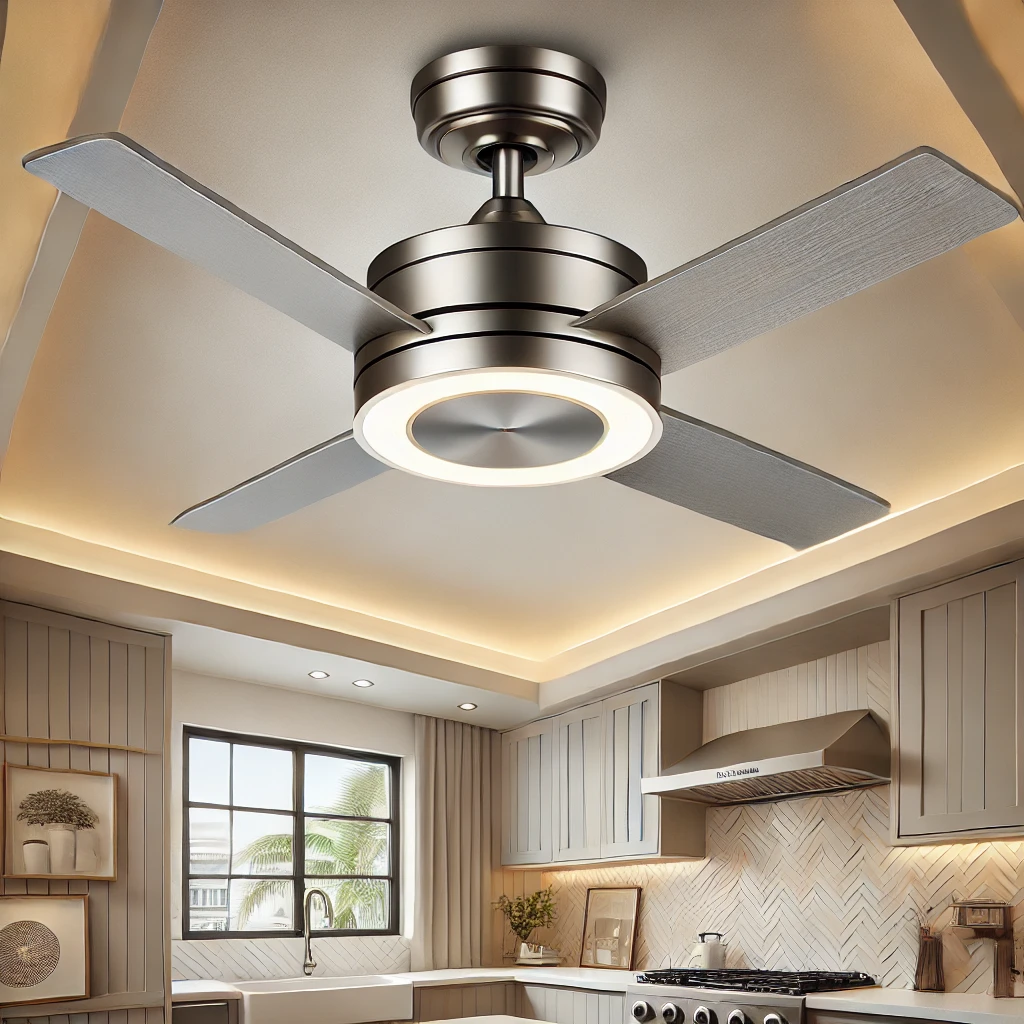Why Kitchen Ceiling Fans Matter
🌬️ Walking into a stuffy kitchen on a warm summer day can instantly dampen your cooking enthusiasm. I’ve been there too! As someone who spends countless hours experimenting with recipes, I understand how crucial proper air circulation is in creating a comfortable cooking environment. Kitchen ceiling fans have become an essential fixture in modern homes, not just for their functional benefits but also for their aesthetic appeal.
The right kitchen ceiling fan can transform your culinary space from uncomfortably warm to pleasantly breezy within minutes. Moreover, these versatile fixtures have evolved significantly over the years, now offering stylish designs that complement various kitchen decors while improving air circulation and energy efficiency.
In this comprehensive guide, I’ll walk you through everything you need to know about kitchen ceiling fans – from their benefits and types to the top models available in the market today. Whether you’re renovating your kitchen or simply looking to upgrade your existing fan, this article will help you make an informed decision. Let’s dive in!
Benefits of Installing Kitchen Ceiling Fans in Your Home
⚡ Energy Efficiency and Cost Savings
Kitchen ceiling fans contribute significantly to energy conservation in your home. Unlike air conditioners that consume substantial electricity, ceiling fans operate on minimal power while effectively circulating air throughout your kitchen. During summer months, a good kitchen ceiling fan can make your space feel 4-8 degrees cooler, potentially reducing your cooling costs by up to 40%.
Many modern kitchen ceiling fans come with energy-efficient DC motors that consume up to 70% less electricity than traditional AC motor fans. This efficiency not only reduces your carbon footprint but also translates to noticeable savings on your monthly utility bills. Furthermore, when used in conjunction with your HVAC system, kitchen ceiling fans help distribute conditioned air more evenly, allowing you to set your thermostat at a more economical temperature.
🌡️ Year-Round Temperature Control
One of the most overlooked advantages of kitchen ceiling fans is their versatility across seasons. In summer, these fans create a refreshing downward breeze that accelerates the evaporation of moisture from your skin, producing a cooling effect. However, did you know that your kitchen ceiling fan can be equally valuable during winter?
By reversing the rotation direction of your fan to clockwise and running it at a low speed, you can gently push warm air that naturally rises to the ceiling back down into your cooking space. This simple adjustment helps maintain a comfortable temperature while reducing the burden on your heating system. The year-round functionality makes kitchen ceiling fans an extremely practical investment for homeowners looking to enhance comfort in their culinary space.
✨ Enhanced Kitchen Aesthetics
Gone are the days when ceiling fans were purely functional fixtures with limited design options. Today’s kitchen ceiling fans come in an impressive array of styles, finishes, and configurations that can complement or even elevate your kitchen’s design aesthetic. From sleek, modern models with integrated LED lights to rustic farmhouse-inspired designs with wooden blades, there’s a kitchen ceiling fan to match virtually any decor theme.
Many contemporary kitchen ceiling fans feature premium materials like brushed nickel, matte black, or bronze finishes that coordinate beautifully with kitchen hardware and appliances. Some models even offer customizable options, allowing you to change blade colors or styles to refresh your kitchen’s look without replacing the entire fixture. When strategically selected, a kitchen ceiling fan can serve as a striking focal point that enhances the overall visual appeal of your culinary space.
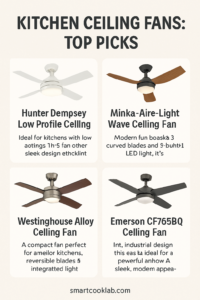
Factors to Consider When Choosing Kitchen Ceiling Fans
📏 Size and Ceiling Height Considerations
Selecting the appropriate size for your kitchen ceiling fan is crucial for optimal performance and proportional aesthetics. As a general rule, kitchens measuring 75-144 square feet typically require fans with blade spans of 42-48 inches, while larger kitchens exceeding 144 square feet benefit from fans spanning 52 inches or more. Undersized fans will struggle to move sufficient air, while oversized models might overwhelm smaller spaces both visually and functionally.
Your ceiling height also plays a vital role in determining the ideal mounting method. For standard 8-9 foot ceilings, flush mount (hugger) kitchen ceiling fans work best by maintaining safe clearance between the blades and countertops. Kitchens with ceilings measuring 9-12 feet may require downrod mounts to position the fan at the optimal height of 8-9 feet from the floor. For particularly high ceilings exceeding 12 feet, extended downrods or specialized high-ceiling fans ensure proper air circulation throughout your cooking space.
💨 Airflow and CFM Ratings Explained
When evaluating kitchen ceiling fans, one of the most important technical specifications to consider is the CFM (Cubic Feet per Minute) rating. This measurement indicates the volume of air the fan can move and directly correlates to its cooling efficiency. Quality kitchen ceiling fans typically offer CFM ratings ranging from 4,000 to 6,000, with higher numbers indicating greater airflow capacity.
However, it’s worth noting that higher CFM doesn’t always mean better performance for your specific kitchen. The ideal airflow depends on your kitchen’s size and layout. For smaller kitchens, a fan with 4,000-5,000 CFM often provides sufficient circulation without creating an uncomfortable draft. Larger open-concept kitchens or those with higher ceilings may require fans with 5,000+ CFM to effectively distribute air throughout the space. Additionally, consider fans with adjustable speed settings, which allow you to customize the airflow based on seasonal needs and cooking activities.
🔊 Noise Level and Motor Quality
The noise level of kitchen ceiling fans can significantly impact your cooking experience and overall kitchen comfort. Premium kitchen ceiling fans operate quietly, producing minimal humming or wobbling even at higher speeds. This quietness is typically achieved through high-quality motors and balanced blade design.
DC (Direct Current) motors have become increasingly popular in modern kitchen ceiling fans due to their superior efficiency and whisper-quiet operation. These motors use up to 70% less energy than traditional AC motors while delivering powerful performance with minimal noise. Though kitchen ceiling fans with DC motors often come with a higher price tag, the combination of energy savings and reduced noise makes them a worthwhile investment, especially for open-concept kitchens where sound can travel to adjacent living spaces.
💡 Lighting Options and Controls
Many kitchen ceiling fans come equipped with integrated lighting fixtures, offering a dual-purpose solution that enhances both air circulation and illumination in your cooking space. When evaluating lighting options, consider the type of lighting that best suits your kitchen needs. LED lights have become the standard for energy efficiency and longevity, providing bright, clear illumination while consuming minimal electricity and requiring less frequent replacement.
The control mechanism for your kitchen ceiling fan also deserves careful consideration. Traditional pull chains offer simplicity but limited convenience, especially for fans installed over kitchen islands. Remote-controlled kitchen ceiling fans provide greater flexibility, allowing you to adjust speed and lighting from anywhere in the room. For the ultimate in convenience, consider smart kitchen ceiling fans that integrate with home automation systems like Amazon Alexa or Google Home, enabling voice control and programmable schedules that can be managed through smartphone apps.
7 Top Kitchen Ceiling Fans for Modern Homes
1. Hunter Dempsey Low Profile Ceiling Fan with LED Light
✅ The Hunter Dempsey stands out as an excellent option for kitchens with lower ceilings, offering a sleek, contemporary design that doesn’t sacrifice functionality for style. With its 44-inch blade span, this fan is ideally sized for small to medium kitchens while providing impressive air circulation with minimal noise. The reversible blades feature different finishes on each side, allowing you to customize the look to match your kitchen decor.
What truly sets the Hunter Dempsey apart is its powerful yet whisper-quiet WhisperWind motor that delivers ultra-powerful air movement without disturbing conversation. The integrated LED bowl light provides energy-efficient illumination with a 16W LED light kit included, eliminating the need for bulb replacements for years. With three mounting options available (standard, low, or angled), this versatile kitchen ceiling fan adapts perfectly to various ceiling types.
2. Minka-Aire F844-DK Light Wave 52″ Ceiling Fan
✅ For larger kitchens or those with a modern aesthetic, the Minka-Aire Light Wave offers an eye-catching design coupled with outstanding performance. Its distinctive wave-shaped blades aren’t just a style statement—they’re engineered to maximize airflow while maintaining quiet operation. The distressed koa finish brings a touch of natural warmth that complements both contemporary and transitional kitchen designs.
This kitchen ceiling fan features a powerful DC motor that delivers exceptional energy efficiency while allowing for 6 different speed options—more than the standard 3 speeds found in conventional fans. The integrated 16W LED downlight provides ample illumination for food preparation areas, with full-range dimming capabilities to adjust the ambiance according to your needs. The inclusion of a wall-mountable remote control adds convenience, allowing you to adjust settings without interrupting your cooking flow.
3. Honeywell Carnegie Rustic Ceiling Fan with Edison Bulbs
✅ For kitchens with farmhouse or industrial design elements, the Honeywell Carnegie offers a perfect blend of rustic charm and modern functionality. This 52-inch fan features a distinctive cage-style housing with five reversible blades and exposed Edison-style bulbs that create a warm, nostalgic glow. The rough pine and iron finish combinations add authentic character that pairs beautifully with kitchen islands or wooden cabinetry.
Despite its vintage appearance, this kitchen ceiling fan incorporates modern technology, including a three-speed reversible motor and dimmable lighting options. The included remote control allows for separate fan and light operation, while the silent motor technology ensures quiet performance even at higher speeds. With its powerful airflow of 5,188 CFM, the Honeywell Carnegie effectively cools larger kitchen spaces while serving as a striking decorative centerpiece.
4. Reiga 52-Inch Modern Ceiling Fan with LED Light
✅ The Reiga 52-Inch Modern Ceiling Fan represents excellent value for homeowners seeking a contemporary kitchen ceiling fan with premium features at a mid-range price point. Its sleek, minimalist design features three ABS blades in a matte finish that resists dust accumulation—a particularly valuable quality in kitchen environments. The integrated 20W LED light provides bright, energy-efficient illumination with three color temperature options (warm, neutral, and cool white) to suit different kitchen atmospheres.
This kitchen ceiling fan stands out for its ultra-quiet DC motor that offers six speeds while consuming up to 70% less energy than conventional AC motors. The inclusion of both summer and winter modes makes it practical year-round, while the wireless remote control adds convenience with timing functionality that allows you to set automatic shutoff times. With a substantial airflow rating of 5,450 CFM, the Reiga delivers powerful cooling performance that belies its affordable price tag.
5. Big Ass Fans Haiku L Smart Ceiling Fan
✅ For those willing to invest in premium quality and cutting-edge technology, the Big Ass Fans Haiku L represents the pinnacle of kitchen ceiling fan innovation. Though commanding a higher price point, this award-winning fan delivers unparalleled performance with an industry-leading efficiency that can reduce cooling costs by up to 30%. Its aerodynamically engineered airfoils are inspired by aircraft technology, creating exceptional airflow with minimal energy consumption.
What truly distinguishes the Haiku L is its integrated smart technology. Its built-in SenseME technology automatically adjusts fan speed based on detected room temperature and occupancy, optimizing comfort without manual intervention. The fan seamlessly integrates with smart home systems including Amazon Alexa, Google Assistant, and Apple HomeKit, allowing voice control and automated scheduling. For design-conscious homeowners, the Haiku L offers customizable options with various finishes and materials that complement high-end kitchen designs.
6. Prominence Home Alvina Ceiling Fan with Remote Control
✅ Budget-conscious homeowners will appreciate the Prominence Home Alvina, which delivers reliable performance and attractive design at an accessible price point. This 42-inch fan is ideally sized for smaller kitchens while still providing effective air circulation. The clean, transitional design features four reversible blades (dark walnut/gunmetal) that complement various kitchen styles from traditional to contemporary.
Despite its affordable pricing, this kitchen ceiling fan doesn’t skimp on important features. The integrated frosted LED light bowl provides pleasant, energy-efficient illumination, while the three-speed reversible motor allows for year-round use. The included remote control adds convenience, and the quick-install system simplifies the installation process—a significant advantage for DIY homeowners. While it may not offer the advanced features of premium models, the Prominence Home Alvina delivers reliable performance where it counts most: quiet operation and effective air movement.
7. Harbor Breeze Mazon 44-inch Flush Mount Ceiling Fan
✅ For kitchens with limited ceiling height, the Harbor Breeze Mazon offers a streamlined flush mount design that maintains the minimum 7-foot blade clearance recommended for safety. This compact 44-inch fan is specifically engineered for smaller spaces (up to 100 square feet), making it ideal for galley kitchens or breakfast nooks. The contemporary brushed nickel finish and three matte-finish blades create a sleek, unobtrusive profile that blends seamlessly with modern kitchen designs.
The integrated 18W LED light kit provides bright, energy-efficient illumination equivalent to a 100W traditional bulb but with significantly lower energy consumption. The three-speed reversible motor delivers surprisingly powerful airflow (4,545 CFM) despite its compact size, while the included remote control adds convenient operation. Though it lacks the advanced features of premium models, the Harbor Breeze Mazon excels at what it’s designed to do: provide effective air circulation in smaller kitchens with lower ceilings.
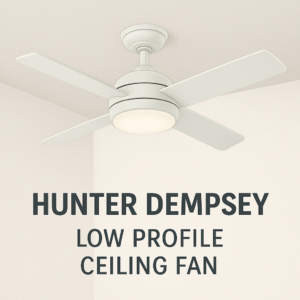
Comparison of Top Kitchen Ceiling Fans
| Model | Size | CFM Rating | Motor Type | Lighting | Smart Features | Price Range |
|---|---|---|---|---|---|---|
| Hunter Dempsey | 44″ | 3,613 | WhisperWind | LED Bowl | Remote Control | $$ |
| Minka-Aire Light Wave | 52″ | 5,024 | DC | Integrated LED | WiFi Compatible | $$$ |
| Honeywell Carnegie | 52″ | 5,188 | AC | Edison Bulbs | Remote Control | $$ |
| Reiga Modern | 52″ | 5,450 | DC | LED w/Color Options | Timer Function | $$ |
| Big Ass Fans Haiku L | 52″ | 5,790 | DC | LED | SenseME Technology | $$$$ |
| Prominence Home Alvina | 42″ | 3,559 | AC | LED Bowl | Remote Control | $ |
| Harbor Breeze Mazon | 44″ | 4,545 | AC | LED | Remote Control | $ |
Ready to elevate your kitchen comfort? Click on any of our recommended kitchen ceiling fans above to check current prices and availability on Amazon. Your perfect air circulation solution is just a click away!
Installation Tips for Kitchen Ceiling Fans
🔧 DIY vs. Professional Installation
Installing kitchen ceiling fans can range from a straightforward DIY project to a task best left to professionals, depending on several factors. If you’re replacing an existing ceiling fan or light fixture with appropriately rated electrical boxes, and have basic electrical knowledge, you might successfully handle the installation yourself. Most kitchen ceiling fans come with detailed instructions, and the process typically involves mounting the bracket, connecting the wiring, assembling the fan, and attaching the blades and light kit.
However, if your installation requires new wiring, electrical box upgrades, or involves very high ceilings, hiring a professional electrician is strongly recommended. Professional installation typically costs between $100-$350 depending on your location and the complexity of the job, but ensures safety and proper function. Remember that incorrect installation can lead to wobbling, noise issues, and even safety hazards, potentially voiding your fan’s warranty. When in doubt, investing in professional installation often proves worthwhile for long-term peace of mind.
🔌 Wiring Considerations and Safety Tips
Safety should be your top priority when installing kitchen ceiling fans. Always turn off power at the circuit breaker before beginning any electrical work, and verify power is off using a voltage tester. Ensure your ceiling electrical box is specifically rated for ceiling fans, which are heavier and create more vibration than standard light fixtures. Fan-rated boxes are typically marked to support up to 70 pounds, accommodating most kitchen ceiling fans.
Pay careful attention to wiring connections, following your fan’s specific instructions. Most fans require connecting black to black (power), white to white (neutral), and green/copper to green (ground) wires. If your fan includes a light kit, there may be additional wiring. Secure all connections with wire nuts and electrical tape for added security. For fans with remote controls, you’ll need to install the receiver according to the manufacturer’s directions. Never cut corners on electrical safety—if you encounter unexpected wiring configurations or feel uncertain at any point, consult a qualified electrician.
📐 Proper Placement for Optimal Performance
The strategic placement of your kitchen ceiling fan significantly impacts both its effectiveness and safety. For optimal air circulation, position your fan in the center of the area you wish to cool, ideally 7-9 feet above the floor. Maintain a minimum clearance of 18 inches between blade tips and walls or cabinets to prevent air flow obstruction and potential damage. In kitchens with islands, centering the fan above the island often provides ideal circulation while creating a balanced design element.
Consider your kitchen’s work zones when determining fan placement. Positioning directly above primary cooking areas helps dissipate heat and cooking odors, but ensure sufficient distance from the cooktop—generally at least 3-4 feet above a gas stove to prevent flame disturbance. For kitchens with defined dining areas, separate fans for cooking and dining zones might provide optimal comfort. Finally, consider natural light sources; placing fans near windows can enhance natural ventilation, creating a more effective cooling system during warmer months.
Maintenance and Care for Your Kitchen Ceiling Fans
🧹 Cleaning Techniques for Different Materials
Kitchen ceiling fans require more frequent cleaning than fans in other areas of your home due to cooking grease, moisture, and food particles that inevitably become airborne during food preparation. For optimal performance and longevity, establish a regular cleaning schedule—typically once a month for active kitchens or bimonthly for less frequently used cooking spaces.
Different blade materials require specific cleaning approaches:
- Wooden blades: Dust with a microfiber cloth or specialized fan duster, then wipe with a slightly damp cloth using mild dish soap diluted in water. Immediately dry with a clean cloth to prevent water damage.
- Metal or plastic blades: These materials generally withstand more moisture and can be cleaned with a damp microfiber cloth using a solution of equal parts vinegar and water to cut through kitchen grease. For stubborn residue, a gentle all-purpose cleaner is suitable.
- Fabric or textured blades: Use your vacuum’s soft brush attachment to remove dust, followed by spot cleaning with a barely damp cloth if necessary.
Remember to clean both sides of the blades and the motor housing, which often accumulates dust that can affect performance. Always support blades while cleaning to prevent bending or warping that could cause wobbling.
⚙️ Troubleshooting Common Issues
Even well-maintained kitchen ceiling fans may occasionally develop issues. Here are solutions to the most common problems:
- Wobbling: This typically results from blade imbalance. First, ensure all blades are screwed in tightly. If wobbling persists, dust accumulation might be the culprit—clean both sides of all blades thoroughly. If the problem continues, use a blade balancing kit (included with many fans or available separately) to identify and correct weight imbalances.
- Unusual noises: Gentle humming is normal, but rattling or scraping indicates problems. Tighten all visible screws and connections, including light fixture components. If noise persists, check that blade holders are properly aligned and securely fastened to the motor housing.
- Remote control malfunctions: First, try replacing the batteries. If issues continue, reset the remote by removing batteries, pressing all buttons to discharge residual power, then reinstalling fresh batteries. Some fans require reprogramming the remote to sync with the receiver.
- Light kit problems: For non-functioning lights, verify bulbs are securely installed and functioning. Check wire connections at the light kit (after disconnecting power). If dimming functions aren’t working properly, ensure you’re using dimmable bulbs compatible with your fan’s control system.
For persistent issues, consult your fan’s manual for model-specific troubleshooting guidance or contact the manufacturer’s customer service department for specialized assistance.
🔄 Seasonal Maintenance Tips
To maximize the efficiency and longevity of your kitchen ceiling fan, adapt your maintenance routine seasonally:
- Spring preparation: Conduct a thorough deep cleaning at the beginning of warmer months when you’ll rely more heavily on your fan’s cooling function. Check that the fan is rotating counterclockwise for summer operation, creating a direct downdraft that produces a cooling breeze.
- Fall transition: When transitioning to cooler months, reverse your fan direction to clockwise. This creates an updraft that gently circulates warm air trapped near the ceiling without creating a cooling effect. This simple adjustment can improve heating efficiency while reducing energy costs.
- Winter maintenance: Even if used less frequently, dust your kitchen ceiling fan monthly during winter months to prevent buildup that can become more difficult to remove over time. Winter is also an ideal time to check and tighten all hardware, as the fan’s natural vibration gradually loosens screws and connections.
- Annual motor care: Once yearly, consider applying a light machine oil to the motor bearings if recommended by your manufacturer (check your owner’s manual, as some modern fans have sealed bearings that should not be oiled). This preventive maintenance extends motor life and maintains quiet operation.
Consistent seasonal attention ensures your kitchen ceiling fan remains a reliable, efficient component of your home’s comfort system throughout the year.

Energy Efficiency and Cost Savings
🌿 How Kitchen Ceiling Fans Reduce Energy Bills
Kitchen ceiling fans can significantly impact your home’s energy consumption in multiple ways. During warmer months, these fans create a wind-chill effect that makes the room feel 4-8 degrees cooler without actually changing the temperature. This perceived cooling allows you to set your air conditioning thermostat 4-7 degrees higher while maintaining the same comfort level, potentially reducing cooling costs by up to 40% according to the U.S. Department of Energy.
In winter, properly used kitchen ceiling fans (running clockwise at low speed) help redistribute warm air that naturally rises to the ceiling. This redistribution can improve heating efficiency by up to 15%, particularly in kitchens with high ceilings where temperature stratification is more pronounced. The year-round utility of kitchen ceiling fans makes them one of the most cost-effective appliances in terms of energy savings relative to purchase price and operating costs.
Consider that a typical ceiling fan consumes only 15-90 watts of electricity depending on speed and model, compared to central air conditioning systems that use 3,500 watts or more. Even running your kitchen ceiling fan continuously costs significantly less than operating air conditioning for just a few hours daily. For maximum savings, remember to turn fans off when the room is unoccupied, as ceiling fans cool people, not spaces.
⭐ Energy Star Rated Kitchen Ceiling Fans Explained
Energy Star certification for kitchen ceiling fans indicates models that exceed minimum federal efficiency requirements by at least 60%. These fans deliver exceptional efficiency through superior motors, blade designs, and lighting systems. On average, Energy Star certified kitchen ceiling fans are 40% more efficient than conventional models, providing significant long-term savings despite potentially higher initial purchase prices.
To earn Energy Star certification, kitchen ceiling fans must meet strict performance criteria including minimum airflow efficiency (measured in CFM per watt at different operating speeds). For integrated lighting, the fixtures must incorporate energy-efficient options like LED technology that consume 75% less energy than traditional incandescent bulbs while lasting 15-25 times longer.
When shopping for Energy Star rated kitchen ceiling fans, look for the CFM/W (cubic feet per minute per watt) rating, which indicates airflow efficiency—higher numbers represent more efficient models. Premium Energy Star fans often feature DC motors, which use up to 70% less energy than traditional AC motors while providing greater speed options and quieter operation. Though the initial investment might be $50-150 higher for Energy Star models, the typical payback period through energy savings is 2-3 years, with continued savings throughout the fan’s 10+ year lifespan.
💡 Smart Features for Maximum Efficiency
Modern kitchen ceiling fans increasingly incorporate smart technologies that further enhance energy efficiency and convenience. These advanced features optimize operation while minimizing unnecessary energy consumption:
- Occupancy sensors automatically detect when the kitchen is vacant and turn off the fan after a predetermined period, eliminating wasted energy when the space is unoccupied.
- Temperature and humidity sensors adjust fan speed automatically based on environmental conditions, increasing as temperatures rise and decreasing as the room cools, maintaining optimal comfort with minimal energy use.
- Scheduling capabilities allow you to program operation based on your typical kitchen usage patterns. For instance, you might schedule higher speeds during regular cooking hours and lower speeds or complete shutoff overnight.
- Integration with smart home ecosystems like Amazon Alexa, Google Home, or Apple HomeKit enables your kitchen ceiling fan to work in concert with other smart devices. This coordination might include automatically adjusting fan operation when the oven reaches a certain temperature or working with smart thermostats to optimize whole-home climate control.
- Smartphone apps provide remote monitoring and control, allowing you to adjust settings even when away from home. These apps often include energy usage tracking that helps identify optimization opportunities and quantify actual savings.
Smart kitchen ceiling fans with these features typically command premium prices ($300-600+), but the combination of convenience and enhanced efficiency makes them worthy investments for tech-savvy homeowners focused on long-term energy conservation. The most sophisticated models, like the Big Ass Fans Haiku L, can reduce energy consumption by up to 60% compared to operating conventional fans and air conditioning without intelligent controls.
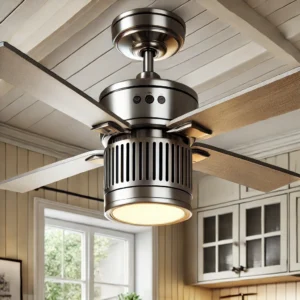
Kitchen Ceiling Fans Design Trends for 2025
🎨 Popular Styles and Finishes
Kitchen ceiling fan design continues to evolve, with several distinct trends dominating the market in 2025:
- Minimalist and sleek profiles remain extremely popular, with fans featuring clean lines, reduced bulk, and blade counts dropping from the traditional five to three or four more aerodynamic blades. These streamlined designs complement contemporary kitchen aesthetics while often delivering improved airflow efficiency.
- Mixed material combinations create visual interest, with manufacturers pairing different finishes like matte black motor housings with warm wood blades or brushed nickel with concrete textures. This trend allows kitchen ceiling fans to serve as transitional elements that bridge different design elements within the space.
- Matte black and champagne bronze finishes have overtaken brushed nickel and chrome in popularity, reflecting broader kitchen hardware trends. These warmer, more sophisticated finishes integrate beautifully with popular cabinet colors and complement the return of natural stone countertops.
- Industrial and farmhouse-inspired designs maintain strong appeal, with cage-style surrounds, exposed hardware, and distressed finishes that add character while complementing rustic kitchen elements. Models like the Honeywell Carnegie exemplify this aesthetic with their vintage-inspired details and Edison bulb lighting.
- Organic, nature-inspired shapes have emerged as a fresh alternative to traditional flat blades. Fans with blade designs mimicking leaves, waves, or aircraft wings add sculptural interest to kitchen ceilings while often improving aerodynamic efficiency.
🔄 Integrating Fans with Kitchen Design Elements
Thoughtful integration of kitchen ceiling fans with your overall design creates a cohesive, purposeful aesthetic:
- Match metals strategically by coordinating your fan’s finish with either cabinet hardware, light fixtures, or appliances. Complete matching across all elements can feel contrived; instead, choose one primary metal finish to repeat between your fan and another prominent feature.
- Consider sight lines when selecting fan styles. In open-concept layouts where the kitchen ceiling fan is visible from living areas, choose a design that complements both spaces. Conversely, in enclosed kitchens, your fan can make a stronger style statement specific to that room.
- Align with ceiling features by echoing existing architectural elements. For coffered or tray ceilings, select fans that enhance these features—perhaps centered within a defined section. For exposed beam ceilings, consider industrial or rustic fan styles that complement the structural elements.
- Scale appropriately to maintain visual balance. While proper sizing for airflow is primary, aesthetic proportion matters too. Generally, larger kitchens with higher ceilings can accommodate more substantial, dramatic fan designs, while compact spaces benefit from lighter, visually unobtrusive models.
- Layer your lighting by utilizing ceiling fans with integrated lights as part of a comprehensive lighting plan. Ensure your fan’s light complements task lighting over work surfaces and ambient lighting from other sources. Dimmable options add versatility, transitioning from bright functional illumination to softer mood lighting.
🖼️ Visual Impact and Statement Fans
While practical considerations remain important, many homeowners now view kitchen ceiling fans as opportunity for artistic expression and focal point creation:
- Architectural statement fans with sculptural qualities draw the eye upward and create vertical interest in the kitchen. Models with unconventional blade shapes, unexpected materials, or distinctive proportions can function as three-dimensional artwork that happens to provide air circulation.
- Oversized designs (60+ inches) make dramatic statements in larger kitchens while providing exceptional air movement. These substantial fixtures create a luxurious impression while often operating more efficiently than smaller counterparts.
- Integrated smart lighting with color-changing capabilities transforms kitchen ceiling fans into mood-setting devices. Models offering adjustable color temperatures or even full RGB spectrum control allow customization of kitchen ambiance for different activities—bright, cool lighting for food preparation transitioning to warmer tones for dining.
- Indoor/outdoor transitional designs have gained popularity with the increasing emphasis on connecting kitchen spaces to outdoor living areas. Weather-resistant fans with styling appropriate for both interior and exterior use create visual continuity between indoor kitchens and covered outdoor cooking spaces.
- Custom color options have expanded as manufacturers respond to design-conscious consumers. Several premium brands now offer customizable components or special-order finishes that allow kitchen ceiling fans to perfectly complement specific cabinet colors or design schemes. Some companies even provide blade wraps or interchangeable components to update the fan’s appearance without complete replacement.
Frequently Asked Questions About Kitchen Ceiling Fans
🔍 Are Kitchen Ceiling Fans Different from Regular Ceiling Fans?
Kitchen ceiling fans do differ from standard residential fans in several important ways that address the unique challenges of kitchen environments:
- Moisture and grease resistance: Quality kitchen ceiling fans feature sealed motors and moisture-resistant components that withstand the higher humidity and airborne cooking residues present in kitchen environments. This specialized construction prevents premature deterioration and maintains safe operation despite exposure to cooking conditions.
- Blade design and materials: Kitchen-appropriate fans often incorporate blades made from materials that resist warping in fluctuating temperatures and humidity levels. Many feature smooth, non-porous surfaces that resist grease accumulation and simplify cleaning—crucial considerations in cooking spaces.
- Lighting specifications: Integrated lights in kitchen ceiling fans typically provide brighter illumination (often 3000-4000 lumens) compared to fans designed for bedrooms or living areas. This enhanced brightness supports detailed food preparation tasks, while options for adjustable color temperature accommodate different kitchen activities.
- Size considerations: Kitchen ceiling fans frequently come in smaller diameter options (42-48 inches) suitable for compact kitchen spaces, with designs that maintain adequate clearance above tall refrigerators, cabinets, and kitchen islands.
- Control mechanisms: Given that cooking often involves wet or messy hands, kitchen ceiling fans increasingly feature hands-free control options like remote controls, wall panels, or smart home integration rather than traditional pull chains.
While standard ceiling fans can function in kitchens, models specifically designed with these kitchen-appropriate features generally provide better performance and longevity in cooking environments.
⏱️ What is the Lifespan of Kitchen Ceiling Fans?
The expected lifespan of kitchen ceiling fans varies significantly based on quality, usage patterns, and environmental factors:
- Motor quality determines longevity: Premium kitchen ceiling fans with sealed DC motors typically last 15-20+ years with proper maintenance. Mid-range models with quality AC motors generally provide 10-15 years of reliable service, while budget fans might require replacement after 5-8 years of regular use.
- Kitchen environment impacts duration: Fans in kitchens experience more challenging conditions than those in other rooms. Exposure to cooking heat, moisture, and airborne grease accelerates wear on components. Fans installed near primary cooking areas typically have shorter lifespans than those in peripheral kitchen locations.
- Usage intensity affects wear: Daily operation at high speeds causes more rapid deterioration than occasional use at lower settings. Fans running 8+ hours daily might show signs of motor strain years earlier than those used more sparingly.
- Maintenance practices make a difference: Regular cleaning to prevent dust and grease buildup significantly extends fan life. Neglected fans accumulate residue that strains motors, whereas well-maintained fans often exceed their expected lifespans.
To maximize your kitchen ceiling fan’s longevity, invest in quality models with appropriate kitchen-specific features, clean blades monthly, check and tighten hardware seasonally, and address small issues promptly before they develop into major problems requiring complete replacement.
🛠️ Can I Replace a Light Fixture with a Kitchen Ceiling Fan?
Converting an existing light fixture to accommodate a kitchen ceiling fan is possible in many cases, but requires careful evaluation of your ceiling infrastructure:
- Electrical box assessment is critical: Standard light fixture boxes typically support only 35-50 pounds and lack the structural strength to safely hold ceiling fans, which are heavier and create vibration. You’ll need to install a fan-rated electrical box (recognizable by their “Rated for Ceiling Fan Support” labeling) that securely fastens to ceiling joists or uses a specialized ceiling fan mounting brace.
- Weight-bearing capacity matters: Besides the electrical box, your ceiling structure must adequately support a fan’s weight and dynamic movement. Most residential ceilings easily accommodate standard kitchen ceiling fans (15-35 pounds), but particularly heavy models might require additional structural support, especially in older homes with plaster ceilings.
- Wiring compatibility requires verification: Kitchen ceiling fans often need different wiring than simple light fixtures, particularly for separate fan and light controls or smart features. Most fans require at least three wires (power, neutral, and ground), with additional wires for independent light control or special functions. If your existing wiring is insufficient, additional electrical work may be necessary.
- Location considerations affect success: Ensure the light fixture’s position provides adequate blade clearance—at least 18 inches from walls, cabinets, and other obstacles—for proper air circulation and safety. Also confirm that the location allows the recommended 7-foot minimum clearance between blades and the floor.
While moderately experienced DIYers can often handle straightforward replacements with proper fan-rated boxes, complex conversions involving new wiring or structural reinforcement typically warrant professional installation. The additional cost of professional help ($100-350) provides peace of mind regarding both safety and function—particularly important in kitchen environments where fire hazards are already a concern.
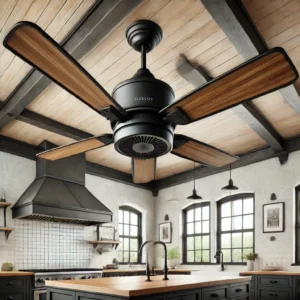
Conclusion: Choosing the Perfect Kitchen Ceiling Fan for Your Space
Kitchen ceiling fans represent a perfect blend of form and function, offering practical benefits while enhancing your culinary space’s aesthetic appeal. As we’ve explored throughout this comprehensive guide, the right kitchen ceiling fan can transform your cooking environment—improving comfort, reducing energy costs, and complementing your design vision.
When selecting your ideal kitchen ceiling fan, prioritize appropriate sizing for your space, quality construction suitable for kitchen conditions, and design elements that coordinate with your overall décor. Consider the long-term value of investing in premium features like energy-efficient DC motors, durable materials, and convenient control options that enhance daily usability.
The seven exceptional kitchen ceiling fans we’ve highlighted represent the best options across various styles, price points, and feature sets. Whether you’re drawn to the sleek contemporary lines of the Minka-Aire Light Wave, the smart technology of the Big Ass Fans Haiku L, or the budget-friendly practicality of the Prominence Home Alvina, there’s a perfect kitchen ceiling fan waiting to elevate your cooking space.
Don’t wait to transform your kitchen environment! Click through to Amazon now to explore our recommended kitchen ceiling fans and enjoy cooler, more comfortable cooking experiences year-round. Your ideal kitchen upgrade is just a click away!
More FQAs:
❓ Are ceiling fans good for kitchens?
✅ Yes, ceiling fans improve air circulation, reduce cooking odors, and help regulate temperature in the kitchen...
❓ What size ceiling fan is best for a kitchen?
✅ A fan between 36 to 52 inches is ideal, depending on kitchen size, to ensure efficient airflow without overwhelming the space...
❓ Can you install a ceiling fan in a kitchen with low ceilings?
✅ Yes, choose a low-profile or flush-mount ceiling fan to ensure safety and efficiency in kitchens with limited ceiling height...
❓ Do kitchen ceiling fans need special blades?
✅ Blades made from moisture-resistant materials like ABS plastic or treated wood are best for kitchens to withstand humidity and grease...
❓ How do you clean a kitchen ceiling fan?
✅ Use a microfiber cloth or a vacuum with a brush attachment to remove dust and grease, and wipe blades with a mild detergent solution...
Recommended for You:
- Kay Dee Designs Sweet Kitties Calendar Kitchen Towel 2025: Top 7 Reasons Cat Lovers Need This Adorable Kitchen Essential
- Farmhouse Style Kitchen Table: 7 Stunning Options That Blend Rustic Charm With Modern Living
- Bronze Kitchen Faucets 2025: Stunning Designs That Will Transform Your Kitchen Instantly
Disclaimer: This article contains affiliate links. If you purchase products through these links, we may earn a small commission at no additional cost to you.

